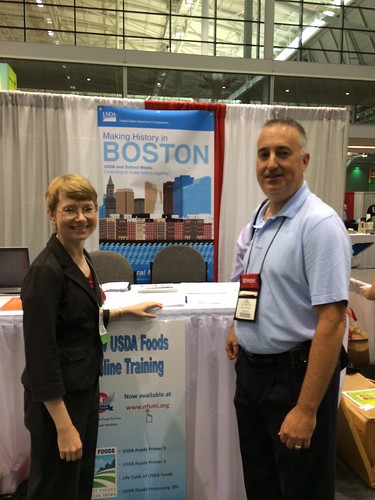
I love it when business travel doesn’t feel so much like a commitment as it does an adventure. That’s the feeling I had this year (and every year) as I packed my bag and headed to the School Nutrition Association’s Annual National Convention (SNA-ANC) in Boston, MA. I was eager and anticipated a week full of sharing, learning, and exploring with a large number of our stakeholders!
I was excited to share with the audience the mission of the commodity purchase program for my agency, the Agricultural Marketing Service (AMS). The program supports U.S. agricultural markets by stabilizing demand, while providing safe, quality foods to federal nutrition assistance programs. At one end of the supply chain, USDA’s domestic food purchases support markets that America’s farms, ranches, and fisheries rely on. On the other end, the “USDA Foods” that we purchase are a critical element in our nation’s food and nutrition safety net.
Partnering with USDA’s Food and Nutrition Service (FNS), we presented two educational sessions devoted entirely to the story of how USDA Foods support American agriculture. We explored the evolution of Federal market support and nutrition assistance programs from the 1930s to the present.
What became clear was that, while the methods and means have changed, the relationship between agricultural market support and USDA’s nutrition assistance programs has always been mutually beneficial to every stakeholder involved.
While exploring the benefits of domestic sourcing of USDA Foods, we were able to answer one popular question often asked by recipients: Where does our food come from? We shared with the audience that AMS contracts with chicken suppliers from 13 different states; potatoes from 7 states; strawberries from 5 states; beans from 5 more! In fact, the agricultural economies in 44 states (and Puerto Rico) are supported by our purchases.
It is important that the program’s recipients and stakeholders know how our program supports American agriculture. Every decision about what we purchase – including how much and when – takes into consideration its impact on domestic agriculture, as well as its ability to supply federal nutrition programs with healthy, nutritious foods. These decisions affect many people – from school foodservice operators to our vendors.
One of my favorite parts of the convention is getting a chance to see the new menu items that vendors are marketing for the National School Lunch Program (NSLP). I took the opportunity to look at how they are using our traditional items like beef, chicken, and tomatoes. I also saw some creative ways to use some of our newer items like mushrooms, apples, and pinto beans. Seeing emerging trends within school foodservice products helps us look for potential ways to change our purchases, improve existing USDA Foods and develop new ones.
I valued my time at the convention because I got a chance to hear candid feedback directly from school foodservice operators, vendors and industry organizations like the American Egg Board and the Mushroom Council. AMS values this feedback and looks forward to using some of these discussions to help strengthen our program.
